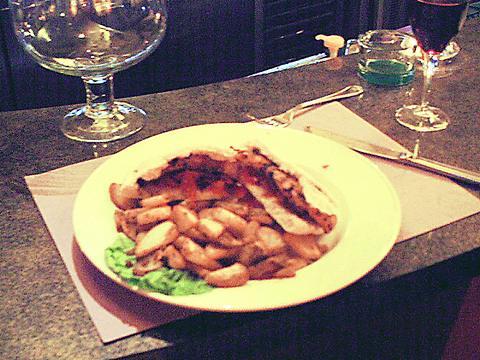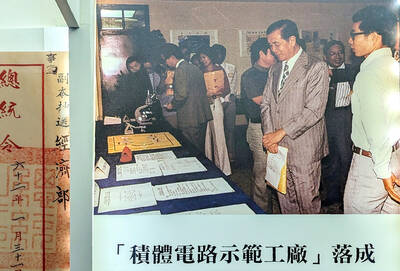Citizen Cain only does business for about eight hours each day. For the several regulars the place has attracted in the half year since it opened, that's not quite long enough.
While plans are afoot to open at noon in an attempt to draw the Tunhwa-Renai area lunchtime crowd, the regulars would rather see it stay open past 2am. That's because Citizen Cain is more of a bar than a restaurant, but anyone coming for a drink would be remiss not to sample the menu -- so why not have it open for lunch?
From the menu of sandwiches, pastas and pizzas, to the lounge music lulling from the DJ booth, and a drinks list with its own Belgian beer section, Cain is distinctly different from the row of restaurants and watering holes lining Dongfeng St.

PHOTO: DAVID MOMPHARD, TAIPEI TIMES
Whether you're wanting a full meal or a bit of bar food, you cannot go far wrong with the hummus. This Taipei rarity is served with a lightly toasted pita that you'll likely need two of -- the bowl holds more hummus than you think it does so you'd better order a second, or third. Cain Chowder and the Cainchetta are also recommended appetizers, but don't miss out on the hummus.
Keeping with the Mediterranean vein, you might want to move on to the falafel on a pita, served with homemade tahini and yoghurt. If you're petering out of pitas after the hummus but have a hankering for the tahini, you would be wise to try the Chicken Cain. Toasted French bread is filled with marinated chicken, grated cheddar and Monterey jack cheeses, tomatoes and just enough jalapenos to give it kick, then topped off with tahini.
Roasted potatoes wait patiently to be dipped in a ramekin of, yes, mustard! Finally! A restaurant that sees mustard as the superior condiment that it is.
Other sandwiches to choose from are a Cain burger, a Caesar sausage dog that's delicious, the Citizen Steak Sandwich and a chicken on a pita (these guys love pita). Perhaps most popular are Cain's pizzas, and for good reason. A flatbread crust is covered with all the things that ought to go on a pizza with nary a pea nor kernel of corn to be found; Italian salami, artichoke hearts, goat cheese, feta, smoked salmon and capers are only a few of the items you'll have to weigh in your decision-making.
The last thing on the menu that is easily digested is the menu itself -- you can actually read it and parts of it are even amusing. The pizza selection begins by saying they've "got some mo' dough' risin!" Here's another palatable tidbit from the menu: "If you are unhappy with your food, we will cover your bill -- that is the Citizen Cain guarantee."

Oct. 27 to Nov. 2 Over a breakfast of soymilk and fried dough costing less than NT$400, seven officials and engineers agreed on a NT$400 million plan — unaware that it would mark the beginning of Taiwan’s semiconductor empire. It was a cold February morning in 1974. Gathered at the unassuming shop were Economics minister Sun Yun-hsuan (孫運璿), director-general of Transportation and Communications Kao Yu-shu (高玉樹), Industrial Technology Research Institute (ITRI) president Wang Chao-chen (王兆振), Telecommunications Laboratories director Kang Pao-huang (康寶煌), Executive Yuan secretary-general Fei Hua (費驊), director-general of Telecommunications Fang Hsien-chi (方賢齊) and Radio Corporation of America (RCA) Laboratories director Pan
The consensus on the Chinese Nationalist Party (KMT) chair race is that Cheng Li-wun (鄭麗文) ran a populist, ideological back-to-basics campaign and soundly defeated former Taipei mayor Hau Lung-bin (郝龍斌), the candidate backed by the big institutional players. Cheng tapped into a wave of popular enthusiasm within the KMT, while the institutional players’ get-out-the-vote abilities fell flat, suggesting their power has weakened significantly. Yet, a closer look at the race paints a more complicated picture, raising questions about some analysts’ conclusions, including my own. TURNOUT Here is a surprising statistic: Turnout was 130,678, or 39.46 percent of the 331,145 eligible party

The classic warmth of a good old-fashioned izakaya beckons you in, all cozy nooks and dark wood finishes, as tables order a third round and waiters sling tapas-sized bites and assorted — sometimes unidentifiable — skewered meats. But there’s a romantic hush about this Ximending (西門町) hotspot, with cocktails savored, plating elegant and never rushed and daters and diners lit by candlelight and chandelier. Each chair is mismatched and the assorted tables appear to be the fanciest picks from a nearby flea market. A naked sewing mannequin stands in a dimly lit corner, adorned with antique mirrors and draped foliage

The election of Cheng Li-wun (鄭麗文) as chair of the Chinese Nationalist Party (KMT) marked a triumphant return of pride in the “Chinese” in the party name. Cheng wants Taiwanese to be proud to call themselves Chinese again. The unambiguous winner was a return to the KMT ideology that formed in the early 2000s under then chairman Lien Chan (連戰) and president Ma Ying-jeou (馬英九) put into practice as far as he could, until ultimately thwarted by hundreds of thousands of protestors thronging the streets in what became known as the Sunflower movement in 2014. Cheng is an unambiguous Chinese ethnonationalist,